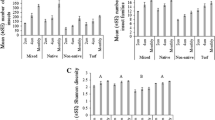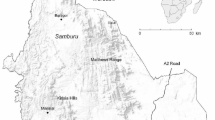Abstract
Archaeobotanical perspectives inform site conservation and presentation at Gordion, Turkey. The historical landscape there includes about 240 royal burial mounds and the archaeological site of Gordion. The tumuli and the historical landscape in which they sit are threatened by agricultural development and suburbanization. The excavated part of the site is exposed to the elements. Protection of the largest tumulus against uncontrolled grazing has reduced erosion and led to biodiversity preservation. Plant management practices coordinated with the architectural conservation team are under development. On stone structures, soft caps are planted with Poa bulbosa and a selective weeding programme aims at keeping deep-rooted plants from destroying the stonework. Education and outreach for local people and tourists include a native plant garden and self-guided walking tours.






Similar content being viewed by others
References
Anonymous (2013) Management plan of Neolithic sity of Çatalhöyük, May 2013. http://www.catalhoyuk.com/sites/default/files/Catal_SMP_EN_Revised.pdf. Accessed 12 November 2017
Caneva G (1999) A botanical approach to the planning of archaeological, parks in Italy. Conserv Manage Archaeol Sites 3:127–134
Davis P (1982–1988) Flora of Turkey, vols 1–10. Edinburgh University Press, Edinburgh
Erder E, Gürsan-Salzmann A, Miller NF (2013) A conservation management plan for Gordion and its environs. Conserv Manage Archaeol Sites 15:329–347
Gürsan-Salzmann A (2005) Ethnographic lessons for past agro-pastoral systems in the Sakarya-Porsuk valleys. In: Kealhofer L (ed) The archaeology of Midas and the Phrygians. University of Pennsylvania Museum, Philadelphia, pp 172–189
Gürsan-Salzmann A, Miller NF, Sadarananda J (2015) Teens and tumuli: Cultural heritage education at Gordion, Turkey. https://www.penn.museum/blog/world/turkey/teens-and-tumuli-cultural-heritage-education-at-gordion-turkey/. Accessed 5 November 2017
Liebhart RF, Brixhe C (2009) The recently discovered inscriptions from Tumulus MM at Gordion: a preliminary report. Kadmos 48:141–156
Liebhart R, Darbyshire G, Erder E, Marsh B (2016) A fresh look at the tumuli of Gordion. In: Kelp U, Henry O (eds) Tumulus as ema. Space, politics, culture and religion in the first millennium bc, part 1. (Topoi Berlin Studies of the Ancient World 27). De Gruyter, Berlin, pp 627–636
Lim A (2012) Soft capping. Evaluation of vegetative capping systems at the Gate and Terrace Building. In: Gordion site conservation program 2011 field report. The Architectural Conservation Laboratory, School of Design, University of Pennsylvania, Philadelphia, pp 78–89
Marston JM (2017) Agricultural sustainability and environmental change at ancient Gordion. University of Pennsylvania Museum, Philadelphia
Masters LA (1997) Monitoring vegetation. In: Packard S, Mutel CF (eds) The tallgrass restoration handbook for prairies, savannas, and woodlands. Island Press, Washington DC, pp 279–301
Miller NF (1999) Erosion, biodiversity, and archaeology: Preserving the Midas Tumulus at Gordion (Erozyon, bioçeşitlilik ve arkeoloji: Gordion’daki Midas Höyüğü’nün korunması, in English and Turkish). Arkeoloji ve sanat 93:13–17
Miller NF (2000) Plants in the service of archaeological preservation. Expedition 42:30–36
Miller NF (2010) Botanical aspects of environment and economy at Gordion, Turkey. University of Pennsylvania Museum, Philadelphia
Miller NF (2011) Managing predictable unpredictability: The question of agricultural sustainability at Gordion. In: Miller NF, Moore KM, Ryan K (eds) Sustainable lifeways: Cultural persistence in an ever-changing environment. University of Pennsylvania Museum, Philadelphia, pp 310–324
Miller NF (2012) Working with Nature to preserve site and landscape at Gordion. In: Rose CB (ed) The archaeology of Phrygian Gordion, royal city of Midas. University of Pennsylvania Museum, Philadelphia, pp 243–258
Miller NF (2015) Soft vegetative roof capping at Gordion: a tutorial video update. https://www.penn.museum/blog/museum/soft-vegetative-roof-capping-at-gordion-a-tutorial-video-update. Accessed 22 November 2017
Miller NF (n.d. a) Gordion research bibliography. https://www.sas.upenn.edu/~nmiller0/GordionResearchBib.htm. Accessed 2 November 2017
Miller NF (n.d. b) Naomi’s Gordion projects. http://www.sas.upenn.edu/~nmiller0/gordion.html. Accessed 2 November 2017
Miller NF, Bluemel K (1999) Plants and mudbrick: preserving the Midas Tumulus at Gordion, Turkey. Conserv Manage Archaeol Sites 3:225–237
Minissale P, Trigilia A, Broogna F, Sciandrello A (2015) Plants and vegetation in the archaeological park of Neapolis of Syracuse (Sicily, Italy): a management effort and also an opportunity for better enjoyment of the site. Conserv Manage Archaeol Sites 17:340–369. https://doi.org/10.1080/13505033.2016.1175906
Robles Garcia NM (2000) Chap. 8, Social issues and the field of archaeological heritage preservation. In: Robles Garcia NM (ed), Corbett J (translation) The management of archaeological resources in Mexico, Electronic document. http://www.saa.org/AbouttheSociety/Publications/TheManagementofArchaeologicalResourcesinMexi/Chapter8SocialIssuesandtheFieldofArchaeol/tabid/1126/Default.aspx. Accessed 13 November 2017
Rose CB (2017) Fieldwork at Gordion, 2013–2015. Am J Archaeol 121:135–178. https://doi.org/10.3764/aja/121.1.0135
Voigt MM (2005) Old problems and new solutions, recent excavations at Gordion. In: Kealhofer L (ed) The archaeology of Midas and the Phrygians. University of Pennsylvania Museum, Philadelphia, pp 22–35
Voigt MM (2011) Gordion: the changing political and economic roles of a first millennium city. In: Steadman S, McMahon G (eds) The Oxford handbook of ancient Anatolia. Oxford University Press, Oxford, pp 1,069–1,094
Voigt MM (2013) Gordion as city and citadel. In: Redford S, Ergin N (eds) Cities and citadels in Turkey: from the Iron Age to the Seljuks. (Koç Institute Monograph) (Ancient Near Eastern Studies, supplement series 40). Peeters Publishing, Leuven, pp 161–228
Zohary M (1973) The geobotanical foundations of the Middle East. Gustave Fischer Verlag, Stuttgart
Acknowledgements
Although this paper focuses on my own activities, the work I describe would not have been possible without the financial support of the University of Pennsylvania Museum of Archaeology and Anthropology and the Gordion project directors, G. Kenneth Sams and C. Brian Rose, excavation director Mary Voigt, assistant director Ayşe Gürsan-Salzmann and many members of the Gordion team. Halil Demirdelen (Deputy Director, Museum of Anatolian Civilizations) has helped spread ideas about the integration of environmental and archaeological preservation; Mecit Vural shares his deep knowledge of the plants of Anatolia and works with me on the demonstration garden. Conversations with Remzi Yılmaz, Zekeriya Utgu and others in Yassıhöyük about agriculture, the weather and pastures have informed many of my decisions. Finally, Mac Marston, Chantel White and Alan Farahani encouraged me to write this up.
Author information
Authors and Affiliations
Corresponding author
Additional information
Communicated by C. White.
Rights and permissions
About this article
Cite this article
Miller, N.F. Historic landscape and site preservation at Gordion, Turkey: an archaeobotanist’s perspective. Veget Hist Archaeobot 28, 357–364 (2019). https://doi.org/10.1007/s00334-018-0689-4
Received:
Accepted:
Published:
Issue Date:
DOI: https://doi.org/10.1007/s00334-018-0689-4




